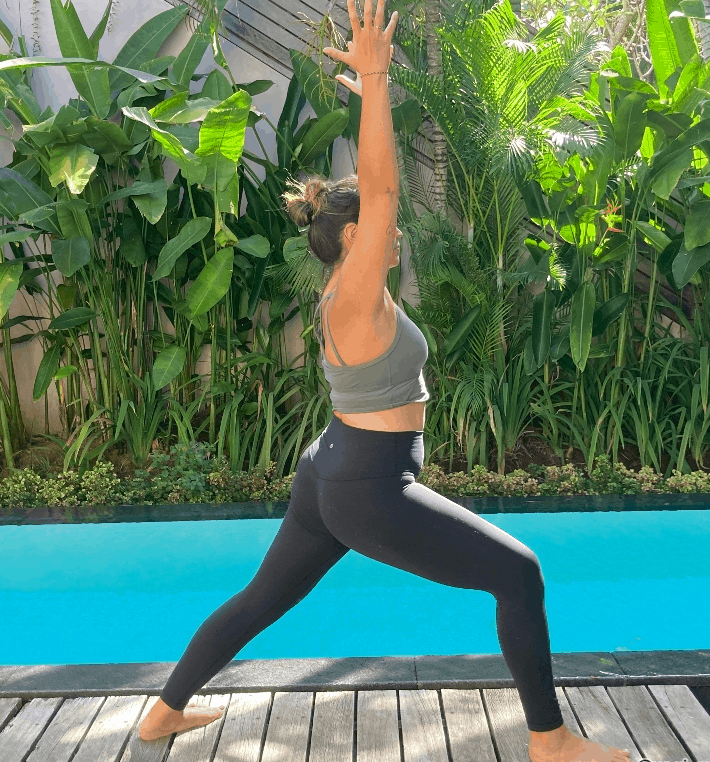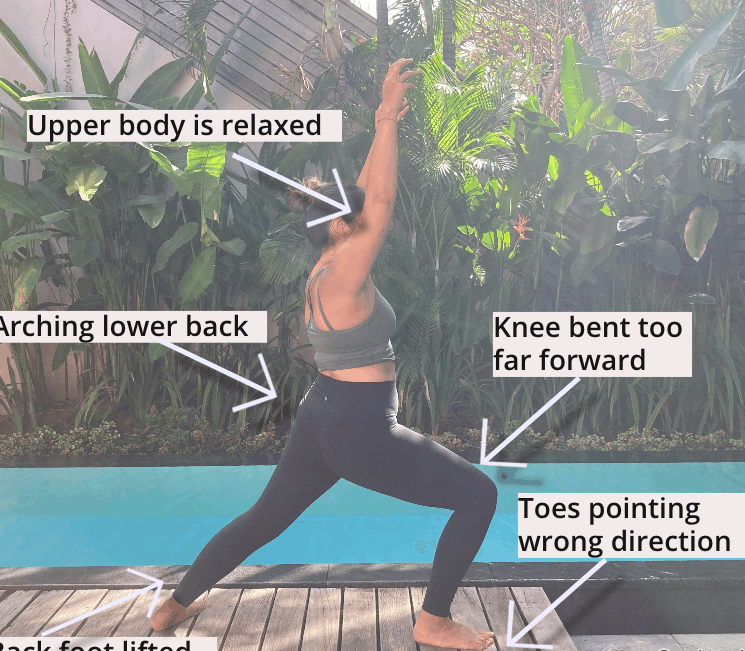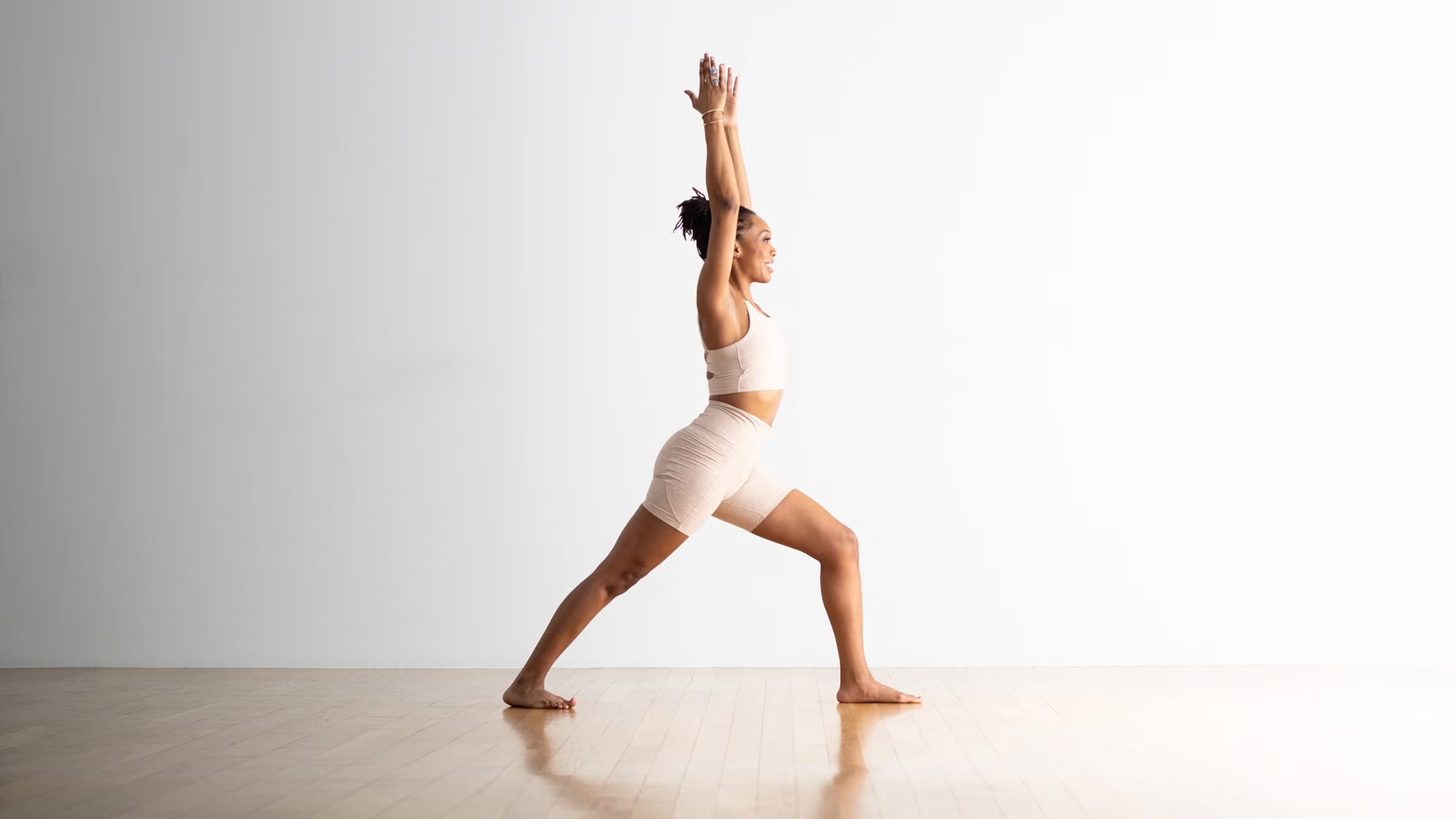Warrior I, or Virabhadrasana I, is one of those yoga postures you’ll nearly always find yourself doing—whether you’re attending a Vinyasa, Hatha, or whatever other class. “Vira” in Sanskrit refers to a hero or warrior, “Bhadra” refers to a friend, and “Asana” refers to posture.
This is a position that asks you to stand tall, express strength, and walk with courage—but always with serenity. With arms raised high, Warrior I represents openness and power, allowing you to draw upon inner confidence and focused stability.
Why Practice Warrior I?
As you transition into Warrior I, you’re entering the vibe of a grounded and fear-less warrior. This pose creates stability and strength from the ground out and assists in energizing your root chakra—the energy center associated with feeling safe and grounded.
Some incredible benefits of Warrior I are:
- Increases blood flow
- Grabs and energizes the body
- Strengthens both the upper and lower body
- Engages and awakens your core
- Opens up the hamstrings, quads, hips, and chest
- Builds inner strength and confidence
Warming Up for Warrior I
Warrior I is a standing posture that typically appears halfway through a class. If you’re taking a Vinyasa or Hatha class, you’ll probably flow through some kind of warm-up and a series of rounds of Sun Salutations before moving into standing postures like Warrior I.
These are some fabulous warm-up poses to warm up your body:
- Sun Salutations (A & B): Performing 2–5 sets will get your entire body warm. Sun Salutation B generally involves Warrior I on each side.
- Mountain Pose (Tadasana): Assists you in getting grounded. Pay attention to activating your thighs and the energy drawing into your center of body. This grounding will transfer wonderfully to Warrior I.
- Tree Pose (Vrikshasana): A standing balance pose that engages your legs and hips. Although Warrior I involves both feet, the stability you develop here comes in handy.
How to Do Warrior I Pose

This pose assists you in grounding and centralizing, creating strength from the soles of your feet to the tips of your fingers.
Here’s how to position yourself in Warrior I:
- From Downward-Facing Dog, bring your right foot in between your hands.
- Press your left heel onto the mat with your toes about 45 degrees.
- Bend the right knee into a 90-degree bend (keep the knee behind your toes).
- Come up, bringing your arms up over your head.
- Slowly turn your left hip forward and your right hip back.
- Shoulders over hips, lengthen the spine.
- Either press palms together or leave palms shoulder-width apart.
- Lift through the chest, relaxing the shoulders.
- Plant both feet into the mat, with your legs stable and firm.
- Gaze forward or look up towards your hands.
Watch Out for These Common Mistakes

It’s a popular pose, but it’s easy to fall out of alignment. Watch out for the following common missteps:
- Front foot misaligned: Your front toes need to point straight ahead, directly in line with the front of your mat—not angled inward or outward.
- Knee too far forward: Your leading knee ought to stack directly over the ankle. If it’s protruding past the ankle, step your back foot back further to widen your stance.
- Back foot lifting: Your back heel ought to remain planted. If it continues to lift, attempt to move your foot forward slightly to ground better.
- Over-arch your lower back: Engage your core and draw your ribs inward. Imagine bringing your belly towards your spine for back support.
- Limp arms or tense shoulders: Engage your arms, chest open, and soft shoulders. Don’t forget to relax your jaw and neck as well!
Modifications to Make Warrior I More Accessible

Warrior I is challenging if you have tight hips, balance problems, or joint pain. Fortunately, you can modify the pose and still obtain all its benefits.
Take these modifications:
- Prop up your back foot: Can’t fully root your heel? Use a rolled blanket or block to support your foot and facilitate grounding.
- Keep your hands lower: If it hurts your shoulders or neck to raise your arms, put your hands on your hips or in prayer at your heart.
- Adjust your stance: If your lower back tension is bothering you, see if spreading your feet apart or moving them closer together will help.
- Use a wall for support: Stand by a wall and place your hand on it to support yourself. It can make you feel grounded with your upper body up and relaxed.
Beginner Tips for Warrior I
- Always modify when needed: Don’t try to hit a picture-perfect pose. Use blocks or adjust foot placement to accommodate your body.
- Listen for the sense of your body: Is your back leg stable on the ground? Are you curving your back? Consciousness keeps you safe and strong in the posture.
- Work at your own speed: No need to “get” the pose right now. Move slowly, discover the shape, and appreciate how it feels to stretch into it.
Warrior I Pose Variations
Feeling adventurous? Try these innovative variations:
- Chair Warrior I: Sit sideways on a chair with both feet planted on the floor and extend your right leg behind you. Plant your foot as you would in Warrior I. Keep your arms raised or place them on the back of the chair.
- Humble Warrior: From Warrior I, place your fingers in back of the back and interlace them. Inhale to raise the chest, and then exhale and bow forward within your front leg. Keep your legs tight and allow your head to drop.
- Crescent Lunge: A variation of Warrior I. Instead of planting your back heel, lift it and remain on the ball of the foot. Square your hips, lengthen, and feel the burn in the legs.
Who Should Be Cautious?
If you’re dealing with injuries in your hips, knees, or ankles, go slow and modify. Those with balance challenges or high blood pressure should avoid looking upward and instead keep their gaze forward. Always listen to your body.
Final Thoughts
Each time you walk into Warrior I, you’re drawing on strength, stability, and rooted confidence. Carry that power with you—off the mat and into your daily life. You’ve got this!

Leave a Reply